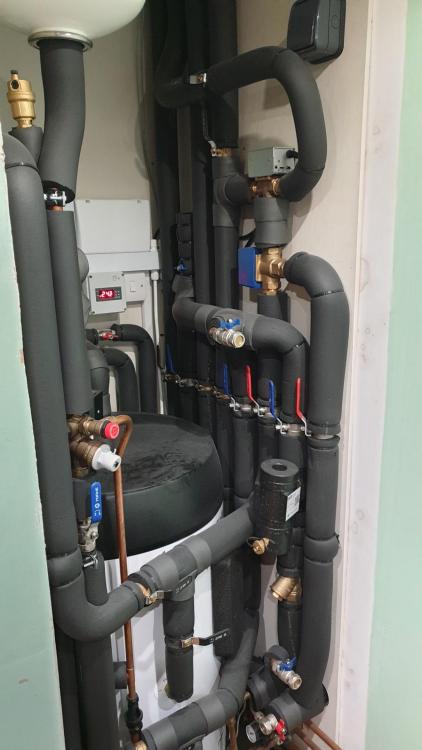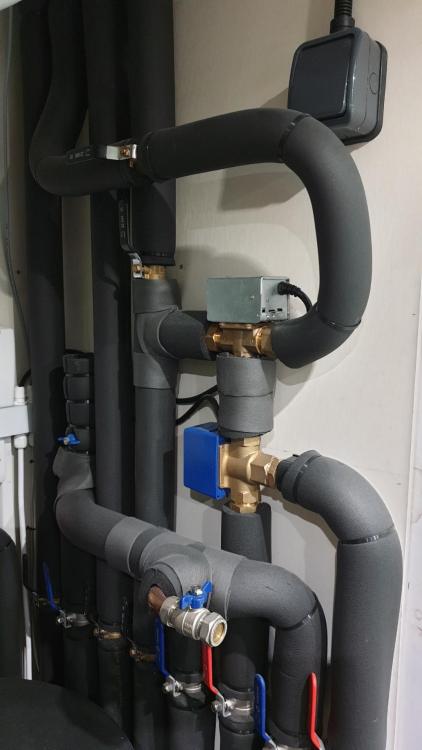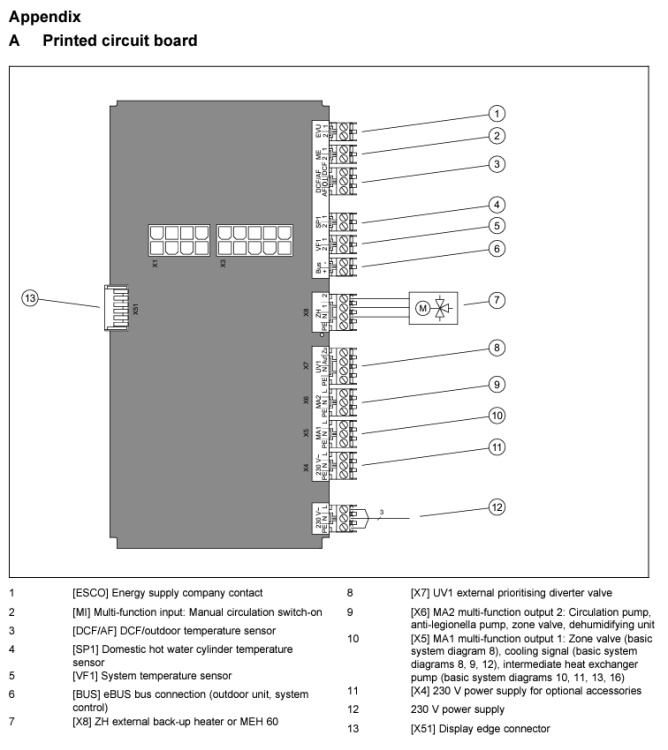-
Posts
14 -
Joined
-
Last visited
Everything posted by yngndrw
-
It appears so as the manuals and datasheet reference cooling. It also shows the required reversing valve in the refrigeration schematic. The installation manual also documents how to wire up an extra valve to shut off an underfloor heating circuit during the cooling mode. I couldn't say for sure if it just works out of the box or if it needs something extra; certainly Vaillant is quite quiet about the need for the "special" module. I can however confirm that the hardware is there for it.
-
All theory as we haven't got an MVHR yet, but yes I think you're right that it depends on how well your cooling is doing: ng is doing: - If the indoor air is warmer than the outdoor air (I.e. Your cooling is not doing enough), then you'd want to use the summer bypass to bring in cooler air. - If the indoor air is cooler than the outdoor air (I.e. Cooling is going well), then you'd want to use the regular heat exchanger to pre-cool the incoming air. Summer bypass is often an optional feature for which you pay more money, so if you can do without it you'd save some money. Either way, if your house has good air tightness then you'd want to maintain the ventilation to control humidity.
-
I think one takeaway from this conversion is that the whole subject is extremely variable due to personal comfort preference, building types, sun load etc. We all seem to be having different experiences and setting it differently! We don't, the plan is to install MVHR which I think will resolve it. Warm air can hold more moisture so if the heating is on and you're constantly exchanging the air with outdoor fresh air, you should always be removing humidity. If the humidity drops too low, you could always use a humidifier. That's the thing with air tightness and insulation, it's really about control. They allow you to then manage the temperature/humidity/air quality yourself, but that still requires something to make the change you want. If you have roof windows, most manufacturers offer some form of insect screen for them so that could be an option.
-
Just to add, one option if you don't have the space for ducting a regular fan coil unit is a vertical unit with a casing such as the Daikin FWL-DAT range. These are essentially just forced convection radiators, complete with drain pan.
-
You're right, but the issue is that underfloor temperatures must be much higher - So high that I'd question the amount of energy it can transfer. For example, using an online dew point calculator, with an air temperature of 23C and a relative humidity of 70%, the dew point is 17.2C so a maximum temperature delta of 5.8C in that example. In our system, the cooling flow temperature is set to 9C so the temperature delta would be 14C for the same example. That difference in temperature delta is really enormous and it would be worse if you were more conservative with the numbers to ensure that you avoid condensation. If the flow temperature has to be in the 20C+ range, I'd seriously question the effectiveness. We use an additional mid-position valve to switch between underfloor + fan coil (For heating) and just fan coil. (For cooling) When we designed the system, we were unsure whether or not we wanted to use the fan coil units for heating but in hindsight, it was silly to even consider that. We could have gotten away with just a 2 port valve to block the underfloor circuit and a relay to invert the "cooling" signal - That would have also helped reduce the condensation as cold water wouldn't be flowing through the valve We have underfloor heating as well, adding the fan coils made a massive difference. Our heat curve setting is currently 0.2 with the fan coil fans on very low. (They are inaudible) It's worth noting that our fan coils are oversized, they can dump over 5kW each with the fan turned up. That's one of the major benefits, the forced convection from the fan makes them extremely efficient even when the fan is on low. It depends, some fan coil units (At least, the ones sold in the UK) are designed specifically for heating and therefore don't have a drain pan. Make sure you find one with a drain pan (Sometimes it's an optional extra) if you're going to use it for cooling and yes this will need to be connected up - Ours just goes to a pipe outside and drips onto the floor. Yes that's exactly right. It's a high-density radiator in a box with a fan and a drain pan. They should be dirt cheap, but as they are quite rare over here they cost a fortune. Sometimes they come with extras such as valve sets and auxiliary electric heaters (Ours did as our supplier didn't know what to order, he'd never seen one before despite working in the HVAC industry) but you can remove all of that.
-
It's worth noting that using a fan coil unit with a heatpump also improves heating - They massively increase the effective surface area of your heat emitters. On the flip side, in the UK fan coil units are incredibly expensive. We spent more on them that we would have buying a separate aircon unit. That being said, it is nice to only have a single outdoor unit and to benefit when heating. I wouldn't use UFH pipes for cooling, the condensation we get on our mid-position valve and filters alone (Which are hard to insulate!) is enough to tell me that it's a bad idea. You'd be supprised at how much condensation is collected via the drain when it's running.
-
Ours has a constant stream of condensate running out of the drains, even with it running (And extracting moisture) for a while it doesn't stop. Indoor humidity rises to around 72% when it's off and drops to 57% when it's on. That's with keeping the indoor temperature at 22C. I'm not sure there's any way to get away from the condensate issue without drained fain coils.
-
If you do that, the fan coils won't provide any dehumidification for the house. That was one of the reasons we spent extra on installing proper fan coils with drains. We just have the cooling mode on a manual switch now, it has been working great and it removes a lot of moisture.
-
This is the one we purchased, same item and works perfectly: https://www.theheatxchange.co.uk/vaillant-plug-coding-vai0020266328
-
Oh I see, sorry when I mentioned manually enabling cooling I mean from within the Vaillant SensoComfort controls, not from something external. We don't have any zones, it's all on pure weather compensation with a steady-state curve - Room influence is fully disabled. (Except for a timed 18C setback temperature overnight) The property is one large zone. (It's an annexe so it's basically and upstairs and a downstairs room.) We didn't want any sub-zoning on the heating to maximise efficiency. (Typical Heat Geek setup basically) Pure weather compensation is working extremely well for the property, upstairs and downstairs are both very comfortable holding a constant 21-21.5C with a COP of 4.5 over the past month - Far better than expected without the underfloor heating. The curve is currently set to 0.5. It's worth noting that we only have the heat pump interface, we don't have the expansion unit so we only have those two MA1 and MA2 outputs - Was really hoping to be able to do it with just that unit. As I say it's all open-plan, so the idea is to put one fan coil downstairs in the kitchen (Supply duct will pull from the hallway so that it doesn't just pull greasy air through the fins) and the other will be upstairs in the bedroom. That should cover the entire property pretty well. So with that in mind, we want to retain a single zone across the property. I can see where the manual cooling mode option is in the Vaillant controls although haven't been able to test that because of the outside temperature limit they've set for some reason, the only thing we seem to be missing is the way to tell it that MA1 should be treated as a cooling zone output - I don't know if that should just automatically work? This is a diagram of the wiring - The heating/cooling mid-position valve is actually plumbed backwards to what you might normally expect, the A port goes to the fan coil units and the B port goes to the radiators: heat-pump-wiring.drawio.pdf Truth tables for the mid-position valve, this is how we have a switch controlling the two modes: If the white wire is connected to a permanent live and grey is connected to the cooling signal from the Heat Pump Interface: White | Grey | Output On | Off | Fan Coil Unit + Radiators (Heating) On | On | Fan Coil Unit (Cooling) If the white wire is also connected to the cooling signal from the Heat Pump Interface: Grey & White | Output Off | Radiators (Heating) On | Fan Coil Unit (Cooling)
-
Pictures as promised: On the wider picture, flow and return from / to the heat pump in the bottom right. The blue diverter valve is for the DHW priority - Down goes to the cylinder. (It goes to the built-in coil and then onwards to a separate DHW charging plate heat exchanger) Above that diverter is the heating/cooling mid-position valve - Right is the cooling pipe which goes upstairs, left is the heating and goes both up and down. The volumiser is on the heating return behind the wall, under the stairs. A lot to fit into a tiny cupboard! Hope that helps to explain the context.
-
I'm not sure how that would work with two separate circuits, the heat pump can only serve one at a time (heating or cooling) so we are really just diverting. Our installer had never done cooling before so the cooling side was an experiment - It's essentially just a standard weather compensated heat pump setup with the cooling tacked on at the hip. We did try to minimise the amount of primary flow pipe before the heating/cooling mid-position valve in order to reduce the amount of pipe which would be susceptible to condensation. No buffer or hydraulic separation, we do have a volumiser on the return though. I can take a picture of the pipework this evening for better context.
-
The flow from the heat pump goes into a DHW priority diverter valve, then from the heating side of that into the heating/cooling mid-position valve. The heating side goes off to the radiators (Will be upgraded to underfloor heating after some building work) and the cooling side goes to the fan coil units. The reason that the heating and cooling is separate is due to condensation. The fan coil units are proper cooling ones with drain pans, so they can be run at a low temperature and remove some moisture from the air. Initially we were just going to use a diverter valve but we changed to a mid-position valve at the last minute so that we could use both the radiators/underfloor and the fan coil units for heating in order to boost efficiency. Right now the fan coils are not yet installed - That's a job for over Christmas.
-
Just wondering if anyone can help with the configuration of the outputs for a Vaillant Arotherm Plus which we've just put in. We have it all piped up with a mid-position valve to switch between cooling and heating modes and have just received the fan coil units for cooling. (Yet to install these, there was a long lead time) The way we have it piped up we can choose to either use the fan coil units just for cooling, or for both heating and cooling. The fan coil units are Daikin FWS06ATV along with the FWS06ATV horizontal drain pan. We didn't get any controllers with them as I realised that the fans just need mains power and a 0-10V signal for the speed, so I'll use some 0-10V light controllers for those to pre-set the fan speeds. In order to get the diverter and fans running at the right times, we need two outputs from the heat pump. Once when there's a cooling demand and one when there's a heating demand. (The cooling demand one drives the valve and the heating demand one is used to drive the fan coil unit fans when they are used for heating) In the Vaillant heat pump interface, we have used MA1 for for the cooling output and MA2 for the heating output (As a zone). The manual suggests that this should be possible: In the controls however, we can't find where to tell it what MA1 or MA2 actually means as the diagram suggests that it could be triggered by multiple things. Sadly we cannot test the configuration as the outside temperature needs to be above 14C for it to go into cooling mode. Can anybody help with this aspect of it? We're happy to put it into manual cooling mode when required. It's also worth noting that we have hot-water priority setup. (The hot water valve is before the heating/cooling valve) As an aside, does anybody know if the Vaillant Arotherm Plus is "smart grid ready"? I believe that some heat pumps can be told to heat the cylinder to a higher temperature if there's excess solar, for example. Thank you!







